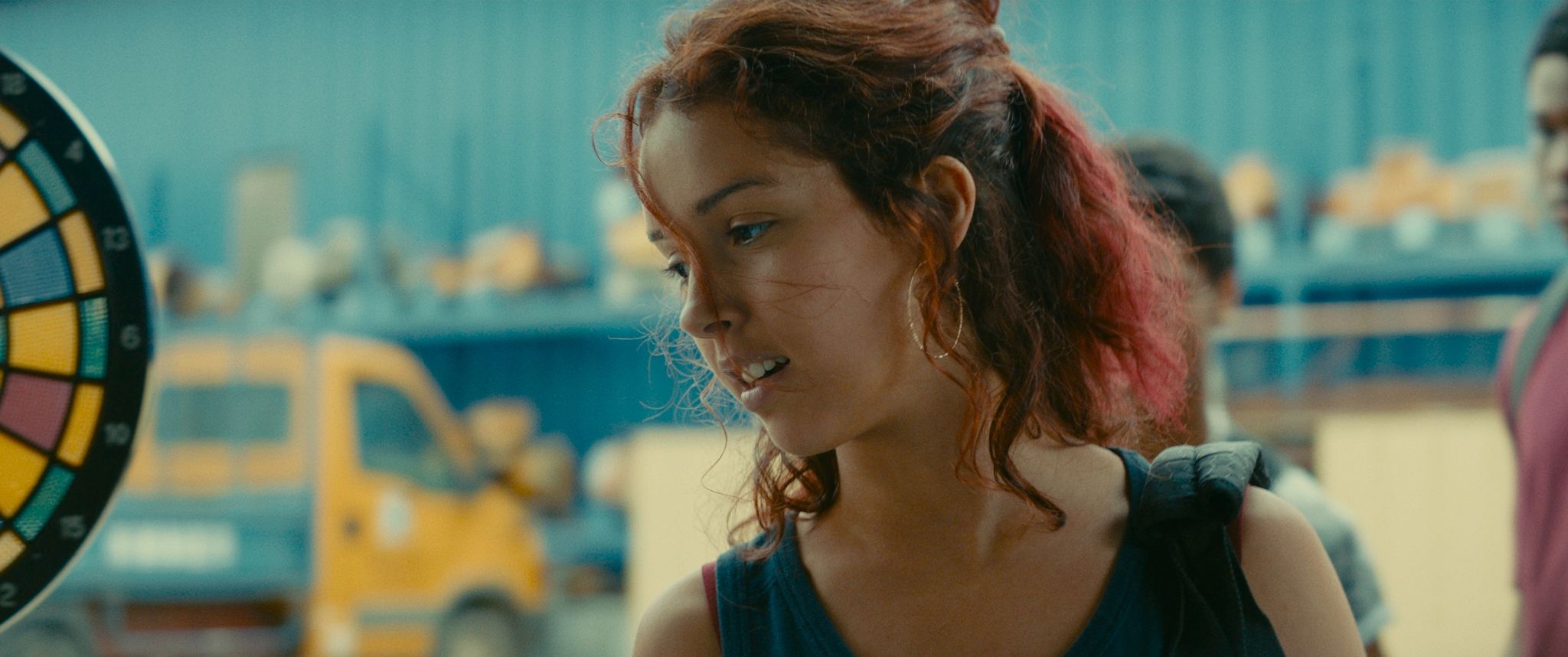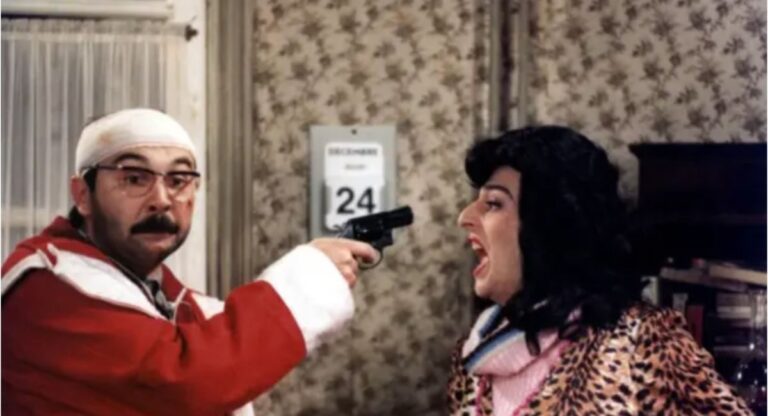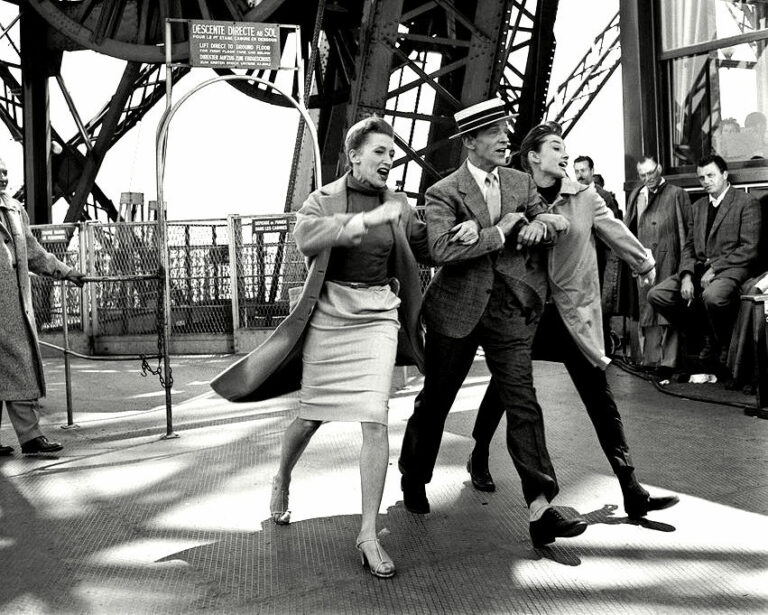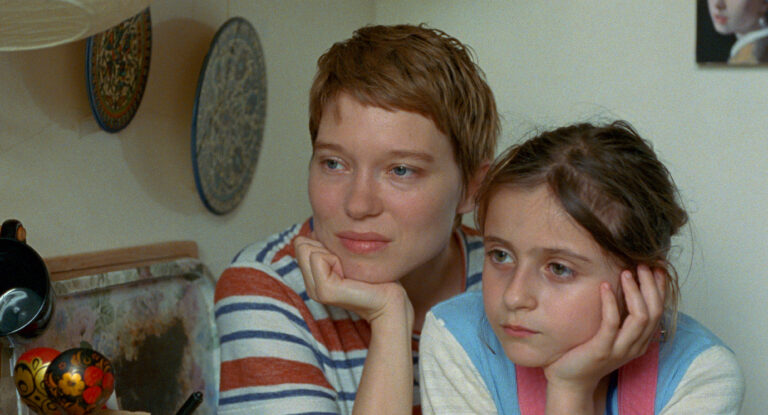After graduating from college with degrees in political science, with an emphasis in urban planning, film directors Fanny Liatard and Jérémy Trouilh were invited by an architect friend to photograph the residents of la Cité Gagarine, a housing project in Ivry-sur-Seine outside of Paris that was slated for demolition. The friends, who had never considered making a movie, fell in love with the place. Not only did they consider the red brick building beautiful architecturally, but its history captivated them. The massive structure that housed 370 apartments was named for Yuri Gagarin, a Russian pilot, cosmonaut and the first man in space, who inaugurated the building named for him when it opened its doors in 1963. Liatard and Trouilh were so entranced by the place and its residents, they thought, what the hell, let’s make a movie.
The film, Gagarine, opens with archival footage of the real 1963 inauguration. Amidst the massive, cheering crowd, a reporter asks a young boy if he’d like to go to space one day. The child hesitates, saying there’s so much he’d have to learn. The reporter says maybe he should learn it.
CUT TO: Fictional present day. Gagarine is set for demolition, and a 16-year-old resident who is unrelated to the boy in the archival footage, Youri (Alséni Bathily), named for the original Yuri, is determined to stop it. He’s lived there all his life, dreaming of becoming an astronaut. His mother has moved in with her boyfriend and left him alone in their apartment. When his friends and neighbors pack up and evacuate, Youri has nowhere to go. I spoke with Liatard and Trouilh this week about their hopeful and heartbreaking film, a narrative feature with documentary in its bones.
What sparked your interest in making a movie about the Cité Gagarine?
Fanny Liatard: We were surprised to learn that it was going to be demolished, because it was quite beautiful. The history of a Russian astronaut coming to inaugurate this place in the 60’s was all about the utopian ideals of the past. And now we were demolishing this building that stood for this idea of living together, which inspired hope in the 60’s. And then there were the stories of all the inhabitants who were going to have to leave. The mix of these things gave us the idea to make a fictional film. It started as a short film, but 15 minutes was not enough to tell the story of Youri’s dreams.
What was your initial idea for the film—the character or the building?
Jérémy Trouilh: The very first spark was linked to the building itself, because when we arrived there, we saw a spaceship from the very beginning: It was this huge red brick building of 400 apartments built in the 60s in this Brutalist architecture that was kind of futuristic at the time. There was something unreal about the place. It was inaugurated by Yuri Gagarin and was linked to an entire mythology of space, not only from the name, but the story. From the beginning, we saw what Youri sees—a spaceship—and then quite quickly when we thought about finding a narrative, we knew we wanted to talk about youths [living there] and quite quickly Youri appeared to us, this young man who would carry these dreams.
It’s the story of a boy and a building, but I couldn’t help getting caught up in the devastating reality of this boy abandoned by his mother. He’s brilliant, the one person who’s trying to save the building, but he’s also young and he makes stupid decisions that put himself in danger. In some ways, he is a hero and, in another sense, he’s just a kid.
Liatard: Your words are exactly right. He’s full of contradictions. He’s between two ages. He’s still a child, even if he has the body of an adult. We think he’s responsible, but he’s not. He’s a child dreaming about going into space. He grows up over the course of the movie and transforms in an extreme way and transforms his dreams into something he can share with the people he loves. He’s someone who can build anything with his hands, but his head is completely in the clouds, in space. When he has an idea in mind, he will never give up. Maybe he interests us because we admire radicalism. We love to invent characters that don’t fit in the world we live in. We have to pay attention to them, because they have amazing ideas and they move walls in concrete ways. What we hoped to do in the beginning of the film by including the archives from the 60’s was show the crowd that was so happy to move into the building, so full of hope. Then we go to Youri’s room and he’s like that kid’s heir, all these years later, still carrying that utopian vision within him.
He feels to me like a captain determined to go down with his ship, clinging to a dream. I’d like to talk about the women in his life: his mom, who abandons him, his wonderful neighbor, who takes care of him, Diana, his love interest, and the astronaut, Claudie Haignéré, who in a way guides him.
Trouilh: Claudie Haignéré was one of the first women in the ESA (European Space Agency). She is a figure of inspiration for many people, boys and girls, and we felt it was nice for Youri to be inspired by such a strong character. We experienced encounters with such strong, empowered women in the cité Gagarine and other housing projects where we’d been to shoot other short films, and we wanted to pay tribute to that strength. That’s why there’s the character of Fari (Farida Rahouadj), who is a sort of substitute mother to Youri, maybe not with the classical attributes of a mother. She’s not soft and sweet. She’s tough, someone who doesn’t demonstrate her affection, at least not with words, but she’s here for him and so many other people. In Diana, Youri finds a lot of himself. She’s also someone who goes all the way for her dreams. She’s very ambitious, and finds a solution for everything. Both of them repair things, but she’s more advanced than he is in because she’s used to change. She’s able to adapt. She’s the one who takes him outside of Gagarine and teaches him that he won’t be able to make it by himself, that he’ll need help from the outside.
The women take care of the solidarity between the people in the community. We also wanted to show the public space isn’t only used by drug dealers, as we often see in movies that take place in housing projects, because it’s not the truth. So, we created this group of women jogging every day and even dancing on the rooftop. Of course, there’s some fantasy in those representations, but the profound meaning of those images is something that comes from reality.
I love the scene when you move from window to window, revealing the diverse faces and lives of many cultures in this community, creating a tapestry bound together by this place.
Liatard: That was a very important part of our story, because we found a beautiful community full of French people coming originally from so many different places, speaking so many different languages. We did workshops with young people, teenagers in Gagarine, many who speak three languages. All the richness of this cultural diversity is often portrayed as a problem in France. We don’t talk directly about immigration and how it’s dealt with by the government, but we show how people build communities, strong beautiful communities in these places that we demolish. We’re showing that when you destroy a building, you’re also destroying a community. That’s the sad part we wanted to show by putting these images at the beginning of the film. All these people are resilient. They will go on with their life, but it’s sad to see. I’m not saying there aren’t problems when you live so close to each other, like in every part of Paris, but there are also beautiful communities. We talked to people about how attached they were to this place and this community.
Can you talk about the line between fantasy and reality in the film?
Trouilh: This was the biggest challenge of doing this movie. We definitely wanted to step aside from reality to show the people and the place in a different way. To find the balance we decided the film would be entirely shot from Youri’s point of view, so the first scene takes place in Youri’s apartment. He goes to the window and looks outside, and from that moment, we adopt his POV and we don’t leave it. The first part of the film is realistic—it’s still full of life. He has dreamy moments because he’s like that, but most of the beginning is a simple way of shooting togetherness. But as the people begin to leave Gagarine, as Youri is left alone in the “spaceship,” in the building, he has to go deep into his dreams to find resilience. That’s where the genre moves toward fantasy, even sci fi, at the end. There was a point where we had to enter Youri’s fantasies and his mind.
The film feels both hopeless and hopeful. There’s this determined, hopeful young man, but he’s ultimately powerless. Is there a political statement the film makes?
Liatard: It’s not a political statement saying that we shouldn’t demolish buildings. It’s more about talking about the residents of these projects in a different way than we usually do in media and films, telling their stories, because there are so many stories to tell. Our set designer found a beautiful formula we kept in mind when talking about the film in general. She said, “Gagarine exists between destruction and weightlessness—effondrement et apesanteur.” It was completely that. We are talking about the end of something, but also big dreams. I hope our film is full of hope, more hopeful than hopeless. We are showing a character who’s very strong and I hope inspiring. We trust in youth, in this boy, to have ideas and new, future utopias for finding ways to live together in future years.
What did the demolition of the building mean to the residents themselves, and how did you get permission to shoot inside Gagarine as it was being emptied of the residents?
Trouilh: There was a process of trust between us and the administration and the city. Because we spent so many years in the place, we connected with many people from the neighborhood and the administration. Shooting there was challenging because the building was closed, but they gave us authorization because we had created a strong link with the people. It was very emotional for the people to say goodbye to Gagarine. We asked hundreds of people who had lived there to come back for the final scene, when people are there to actually say goodbye. Many people had left the place years before and were meeting again for a fictional moment, knowing that a few days after that, the real demolition was going to begin. So, we experienced a beautiful moment with the inhabitants and we’d become friends with many of them. On the 31st of August of 2019, the shoot hadn’t finished, but we had just finished the part inside the building and they began to demolish it! They did a big event and hundreds and hundreds of inhabitants came back. There was a former inhabitant who had created a song to sing, to say goodbye to Gagarine. Everyone was crying.
Andrea Meyer has written creative treatments for commercial directors, a sex and the movies column for IFC, and a horror movie script for MGM. Her first novel, Room for Love (St. Martin’s Press) is a romantic comedy based on an article she wrote for the New York Post, for which she pretended to look for a roommate as a ploy to meet men. A long-time film and entertainment journalist and former indieWIRE editor, Andrea has interviewed more actors and directors than she can remember. Her articles and essays have appeared in such publications as Elle, Glamour, Variety, Interview and the Boston Globe.








